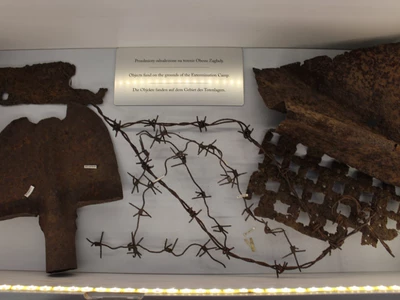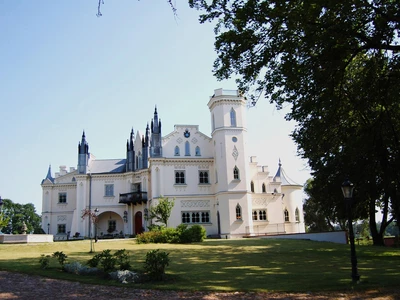Penal Labour Camp Treblinka I functioned from the summer of 1941 to the end of July 1944. The initiator and organizer was the county staroste in Sokołów Podlaski, Ernst Gramss. The commandant of the camp throughout the entire period was Theo van Eupen. German service consisted of about 20 people. They had help from a group of guards (about 100 people) – mainly Ukrainians. Over 20,000 prisoners went through the camp, of which about 10,000 died or were shot. The operation of the camp can be divided into several periods:
I. June – September 1941 – initial phase, the amp at that time had several dozen prisoners and was located in the farm buildings of the gravel pit; these prisoners built a proper camp.
II. September 1941 – July 1942 – the camp was already on the eastern side of the gravel pit. The operation of the camp was made public on November 15, 1941. During this period there was no permanent division into Polish and Jewish prisoners. Mostly Poles and a small group of Jewish craftsmen from nearby towns, such as Kosów Lacki, Węgrów, Sadowne, Stoczek Węgrowski and Sokołów Podlaski, stayed here.
III. July 1942 – November 1943 – during this period, the extermination camp was located 2 km away. At that time, the number of Jewish prisoners, both craftsmen and workers, increased. There was a high rotation and mortality of prisoners. The dead were replaced by new prisoners, selected from transports sent to extermination. The labour camp in those months existed “in the shadow” of Treblinka II extermination camp.
IV. November 1943 – July 1944 – in November 1943, the extermination camp was completely liquidated, and in July 1944, just before the arrival of the Red Army, the labor camp was liquidated as well. During this period, the number of Jewish prisoners decreased, the rest were mainly professionals and prisoners working in the administration. The prisoners’ conditions of living improved, they even received packages from Polish Red Cross twice.
Text based on the book: E. Kopówka, Treblinka. Nigdy więcej, Siedlce 2002, pp. 77-109
The Treblinka extermination camp (centre) was built by the Germans in mid-1942 next to a nearby penal labour camp. It was established as a part of Operation Reinhard, the goal of which was to eliminate the Jewish population. It covered an area of 17 hectares and was surrounded by a high barbed wire fence. The camp was operated by a command staff of 30-40 Germans and Austrians who were assisted by around 100-120 guards, mainly Ukrainians. Doctor of medicine Irmfried Eberl became the first commandant of the camp, later followed by Franz Stangl. Kurt Franz was the deputy commandant.
The first transport of prisoners arrived on 23 July 1942, bringing Jews from the Warsaw ghetto. From that day on, Jews were brought here mainly from the occupied Poland, but also Czechoslovakia, France, Greece, Yugoslavia, the USSR, as well as Germany and Austria. Romani and Sinti people from Poland and Germany were also brought here.
The prisoners were gassed with exhaust fumes in gas chambers built specifically for that purpose. Around 800,000 people are estimated to have died here. To cover up these war crimes, the bodies were cremated on specially constructed grates.
On 2 August 1943, an armed uprising organised by prisoners broke out in the camp. Out of 840 people, only about 200 managed to escape, Not more than 100 survived the war. After the uprising, the camp was being slowly shut down. In November 1943, the camp’s structures were dismantled. A farmhouse was built for a Ukrainian family; the ground was ploughed and planted with lupine. The buildings were burned down before the approach of the eastern front.


www.muzeumtreblinka.eu







